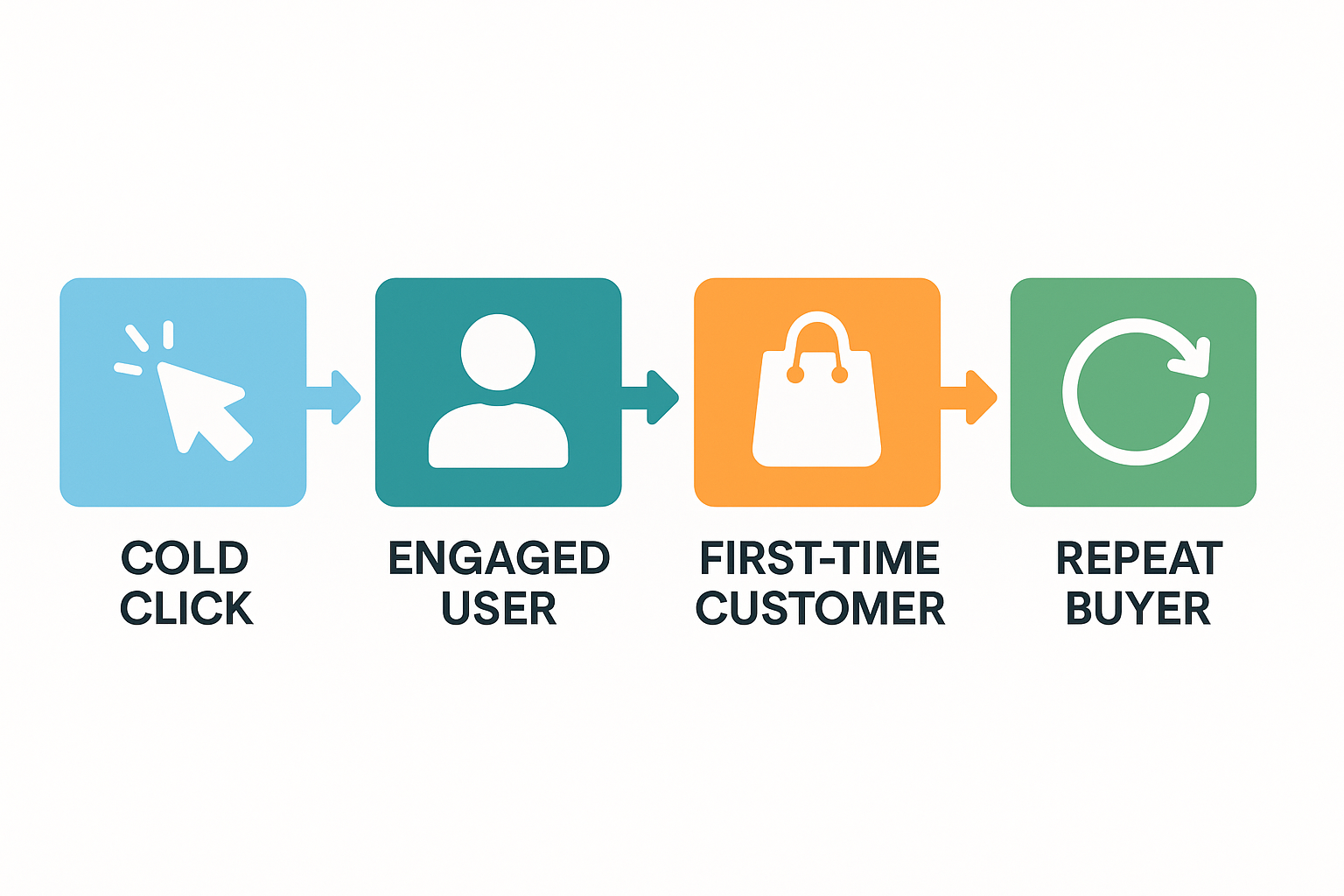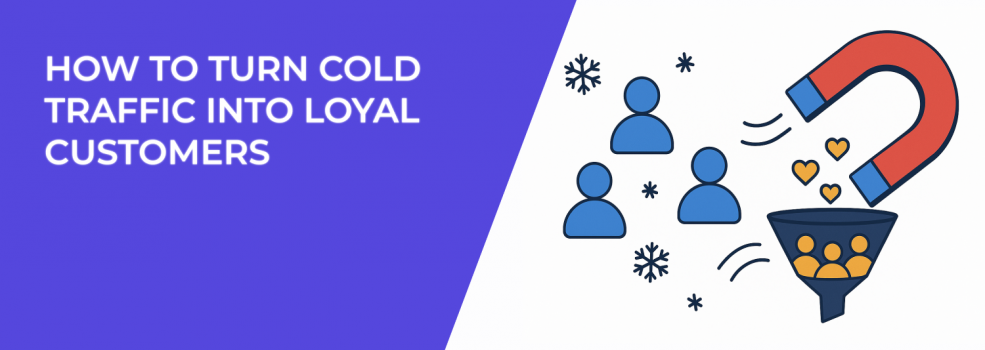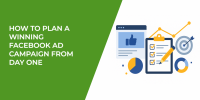Cold traffic might seem like a waste of budget — clicks without conversions, impressions without intent. But here's the catch: every loyal customer was cold traffic at one point.
The difference? Smart advertisers know how to warm up cold leads without pushing too hard, too fast. They build systems — not just ads — that earn trust, deliver value, and guide prospects down a path worth taking.
Let’s walk through the exact strategies you can use to transform cold traffic into paying, loyal customers.
1. Understand the Cold Audience Mindset
You can’t convert strangers by treating them like fans. Cold audiences don’t know who you are, why you matter, or if they should care.

Most people seeing your ad are:
-
Distracted — they're scrolling while waiting for coffee, watching TV, or checking messages.
-
Skeptical — they’ve seen many promises that didn’t deliver results.
-
Not actively shopping — they aren’t browsing with the intent to buy, so your ad needs to earn their attention first.
Your job isn’t to sell immediately. It’s to catch their attention with something meaningful, relatable, or useful.
So how do you speak to them? Use empathy over hype. Lead with a relatable hook. Provide helpful information before asking for anything. And when in doubt — simplify your offer.
2. Use Targeting That Filters for Context
You can waste thousands trying to show your ads to the wrong crowd. That’s why targeting matters.
Instead of relying on outdated interest targeting, platforms like LeadEnforce help you build Facebook audiences from real behavior, not just broad interests — you can target users who follow specific Facebook groups and pages.
This lets you go beyond cold demographics and reach people who’ve:
-
Liked your competitors’ content — they already follow similar products or services.
-
Followed niche-relevant pages — for example, a Facebook page about home brewing for a beer equipment brand.
-
Engaged with related topics — such as commenting on ads for similar solutions.
Need a primer on better audience targeting? Check out Facebook Ad Targeting 101.
3. Create a Magnetic Hook
When someone sees your ad, you have 2–3 seconds to win their attention.
A strong hook isn’t just a catchy phrase — it’s a way to make someone pause and care. Here are several approaches:
-
Make a bold promise: For example, "Cut your lead costs in half in 14 days — here's how." This grabs attention through a quantifiable, time-based benefit.
-
Highlight a specific pain point: "Still struggling with low ROAS? This strategy fixed it for our last 12 clients."
-
Share a surprising fact: "Most Facebook ad failures aren’t due to bad creatives — they come from misaligned targeting."
-
Use an unexpected visual: A split-screen before/after ad design or a pattern interrupt like a meme-style image in a professional context.
Whatever you choose, make sure it connects directly to a real-world concern your target audience faces.
4. Send Them to a Frictionless, Trust-Building Landing Page
Cold traffic clicks mean nothing if your landing page pushes them away. To keep them engaged, focus on clarity, consistency, and credibility.
Key elements to include:
-
Consistent messaging: If your ad talks about increasing B2B leads, the landing page should not suddenly shift to discussing branding or e-commerce strategies.
-
Minimal clutter: Remove any distractions — don’t ask for multiple actions at once (e.g., watch a video, read a case study, sign up for a trial).
-
Tangible proof: Place a testimonial, case study snippet, or screenshot near the top of the page.
-
A single clear CTA: Use one well-placed button, like "Get the Free Audit" or "Download the Guide."
Example: A software company offering a free tool can show a quick GIF demo, 1–2 bullets of benefit, and a simple opt-in form, all above the fold.
5. Give Before You Ask
Cold traffic won’t hand you their email, money, or time unless they get something valuable first.
Here’s what works and why:
-
Short lead magnets: A one-page checklist for fixing ad performance offers quick, practical value and lowers commitment barriers.
-
Interactive quizzes: Tools like “What Type of Campaign Should You Run?” guide users to self-discovery and give you segmentation data.
-
Explainer videos: A two-minute video showing how your service helped a similar client gets more attention than blocks of text.
-
Mini email sequences: A 3-day email course on reducing CAC gives you multiple chances to build familiarity before pitching anything.
Want to see this in action? Here’s how to create a lead magnet funnel with Facebook Ads.
6. Retarget, But Smarter
Most retargeting strategies fail because they simply repeat the original message. If your cold traffic didn’t engage the first time, why would seeing the same thing again change anything?
Here’s how to retarget with nuance:
-
Use social proof to validate: Share a testimonial quote or video, such as "I was skeptical too, but this tool saved us $800/month in ad spend."
-
Offer a deeper explanation: If they clicked but didn’t convert, try a follow-up that explains your product's difference in more detail.
-
Incentivize thoughtfully: A subtle, limited-time bonus (like a free onboarding session) works better than aggressive discounts.
-
Create content-based retargeting: Direct them to a blog post like "Why Facebook Ads Fail: 7 Targeting Issues You Didn’t Know About" — it reframes your authority without repeating a pitch.
Segment your retargeting audience:
-
Visited but didn’t convert: Offer testimonials or a feature breakdown.
-
Watched a video: Follow up with a demo or behind-the-scenes content.
-
Engaged with a quiz or lead magnet: Introduce a low-bar offer such as a free trial.
For more guidance, visit How to Re-Engage Cold Audiences with Facebook Ad Targeting.
7. Measure What Actually Matters
You can’t fix what you’re not tracking — but most people focus on vanity metrics.
Here’s what to focus on, and what each tells you:
-
Click-through rate (CTR): If it’s low, your ad isn’t resonating — time to rethink your headline or creative.
-
Bounce rate: A high bounce rate on your landing page usually signals a mismatch between ad promise and page content.
-
Time on page: If visitors leave in under 10 seconds, your hook might not be strong enough or your layout could be overwhelming.
-
Cost per lead/customer: This determines whether your campaign can scale — are you profitable, or just busy?
-
Retention and lifetime value (LTV): These metrics show how well your funnel turns a cold lead into a repeat buyer or subscriber.
If your ad sets aren't delivering at all, you may be hitting targeting or delivery issues. This guide can help: Why You See 'Ad Set May Get Zero' on Facebook and How to Fix It.
Wrapping Up: From Cold Clicks to Loyal Fans
Turning cold traffic into loyal customers is a game of systems — not shortcuts.
It’s about:
-
Showing up with relevance — understand your audience’s intent and language.
-
Offering value without pressure — give people a reason to care before you ask them to act.
-
Building trust gradually — through content, proof, and consistency.
-
Learning from real signals — track what matters and test with purpose.
Most advertisers give up on cold traffic too early. But if you stay consistent, test smart, and focus on experience over conversion tricks — you'll end up with more than customers

